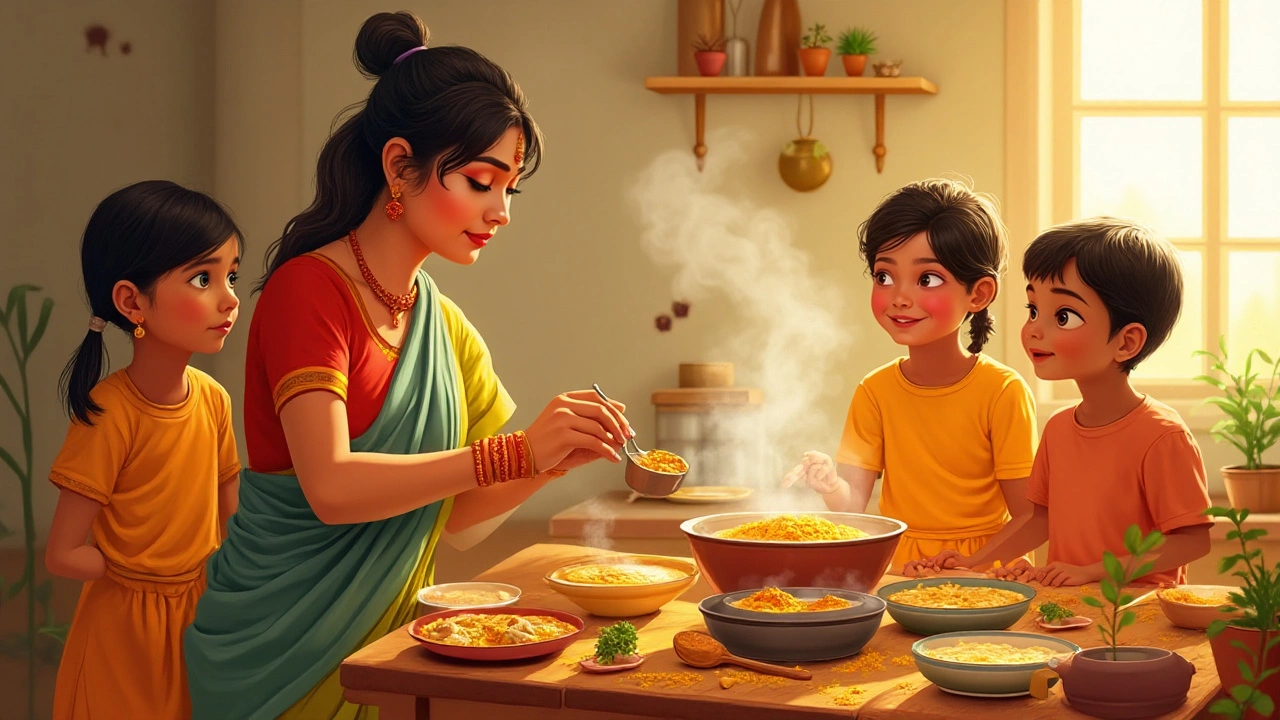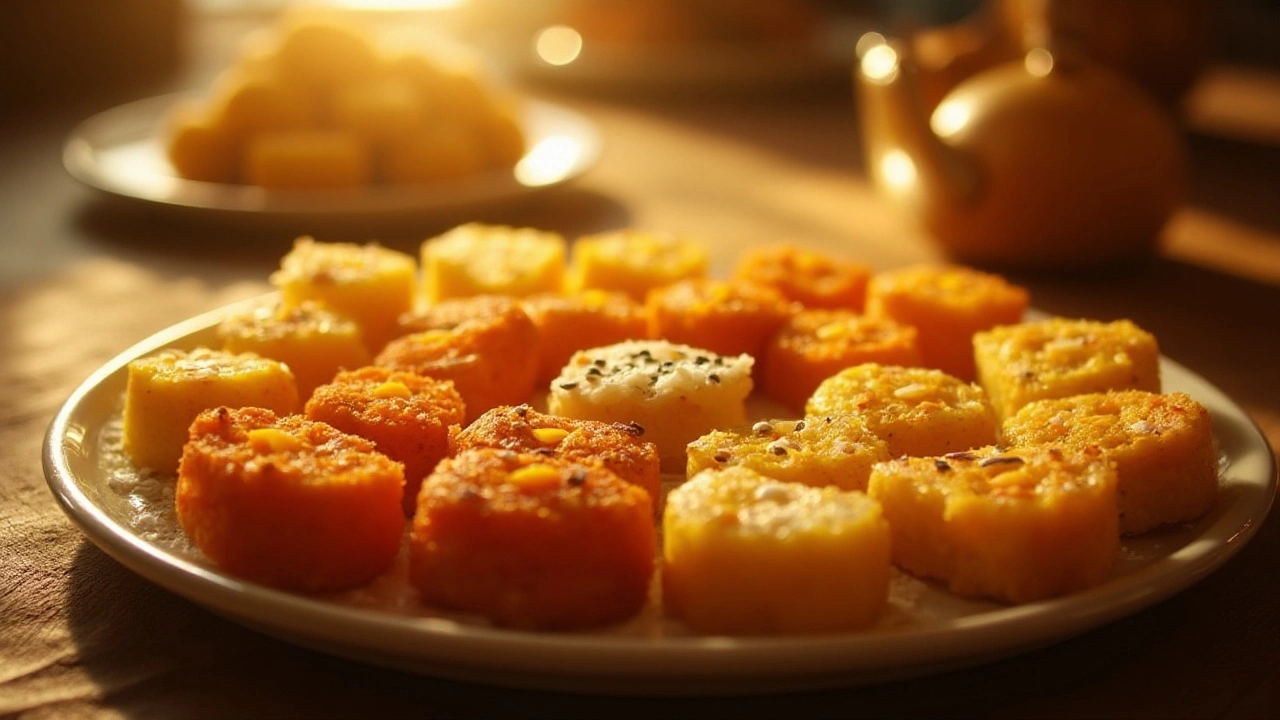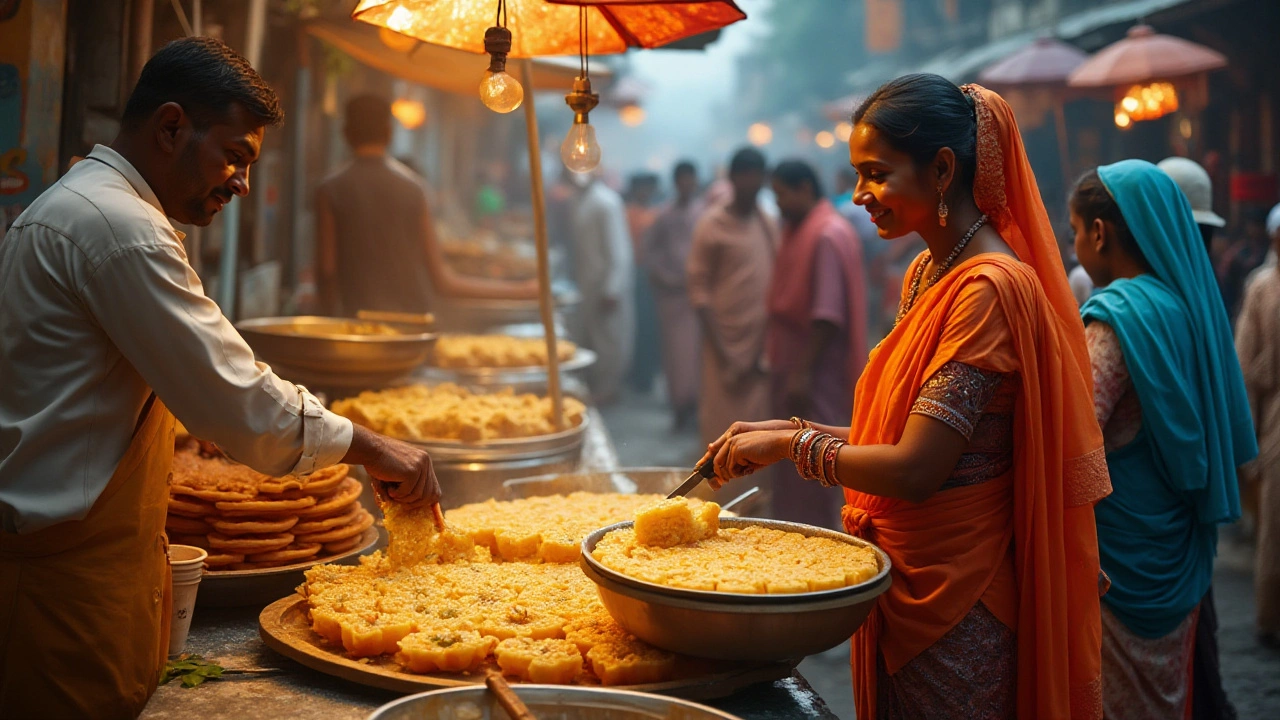Gujarat, a vibrant state in western India, introduces us to a culinary gem that has crossed borders and tantalized palates globally. Known as dhokla, this savory sponge cake is more than just a dish; it's an experience. Born from a rich tapestry of cultural influences and regional flavors, dhokla is a testament to the creativity and diversity of Gujarati cuisine.
With its light, airy texture and subtly tangy taste, dhokla is crafted from fermented rice and chickpea batter. It's a dish that combines simplicity with sophistication, offering a versatile snack loved by people of all ages. Whether enjoyed for breakfast, as a snack, or even as part of a main meal, dhokla seamlessly fits various occasions.
- Origins and Historical Significance
- Ingredients and Preparation Method
- Types and Variations
- Nutritional Benefits
- Serving Suggestions and Pairings
Origins and Historical Significance
The origins of dhokla trace back to the ancient heritage of Gujarat, where culinary traditions were as deeply rooted as cultural ones. This savory sponge dish is believed to have been created centuries ago, during a time when fermentation became a common method for preserving food and enhancing its flavors. The process of fermenting rice and chickpea flour used in making dhokla imparts a unique tanginess that distinguishes it from other Indian delicacies. One fascinating theory is that dhokla might be a product of India's fascination with chemistry, particularly in the realm of biochemistry, which played a significant part in ancient cooking techniques aimed at making food both nutritious and palatable.
Exploring historical texts and culinary manuscripts from the region reveals references to dhokla-like dishes under different names. These early mentions suggest a longstanding tradition of crafting similar steamed, fermented creations within Gujarati households. The dish became a staple in the local diet due to its adaptability and ease of preparation, paired with the bountiful availability of its core ingredients. The local climate, conducive to fermentation, also played a pivotal role in the dish's popularity. Interestingly, an account from the 16th-century Jain literature sheds light on the communal nature of meals, which often featured dhokla, symbolizing not just sustenance, but unity and togetherness.
Over time, as trade routes opened and cultures mingled, the recipe transformed and incorporated influences from bordering regions. This ensured that dhokla adhered to vegetarian principles, widely practiced across Gujarat, particularly due to the influence of Jainism and Hinduism. An intriguing historical reference suggests that dhokla was often prepared during religious fasting periods, as its lightness and texture provided a perfect break from the usual meals without breaching dietary restrictions.
Renowned food historian, Dr. Pushpesh Pant, once noted, "The culinary journey of dhokla mirrors the spiritual and even climatic story of Gujarat, where simplicity and flavor go hand in hand."
As modernity crept in, dhokla crossed the boundaries of Gujarat, finding its way to urban India and eventually into international kitchens. Food festivals, cultural exchanges, and the diaspora community played a crucial part in this spread, as people shared ancestral recipes with passionate fervor. Dhokla has since evolved into a globally recognized dish, with various versions found in culinary hotspots around the world, each tweaking the original recipe to suit local tastes while retain its authentic core. Its journey from an ancient dish to a contemporary favorite showcases the dynamic nature of food and tradition, encapsulating the essence of Gujarati culinary brilliance in every bite.
Ingredients and Preparation Method
When you think of Gujarati cuisine, the delightful Dhokla is sure to pop up as a starring dish. The basic ingredients include chickpea flour (also known as gram flour or besan), rice, yogurt, and a handful of spices to blend it all together. Crafting this flavorful and spongy delight begins with fermenting a batter of chickpea flour mixed with water, a bit of yogurt for that tang, and rice. The art of making a perfect Dhokla isn't just about the flavors; it's about creating a balance to achieve the soft, porous texture that melts in your mouth.
The traditional method involves allowing this batter to sit overnight, giving enough time for the fermentation process. Fermentation is key, as it not only enriches the taste but also makes the Dhokla light and fluffy. If time is a constraint or immediate cravings speak louder, a touch of Eno fruit salt or baking soda can be your quick fix, though purists might frown at this shortcut. Once fermented, the batter is seasoned with salt, a dash of turmeric powder, which imparts that characteristic sunny yellow hue, and a smidgen of green chili paste, adjusting to taste preferences.
Steaming is the preferred cooking method, and here's where a traditional Dhokla steamer comes in handy. Oil the container well, ensuring the batter doesn't cling to the sides. As the batter begins to cook, the magic unfolds. The kitchen fills with the comforting aroma of a Dhokla in the making, while eager anticipation grows. The batter rises to form a soft, springy layer, each bubble within a testament to the careful fermentation done just right. Gourmands and chefs alike might say this isn't merely cooking; it’s crafting an experience.
An excerpt from Cook's Delight states, "The secret to an impeccable Dhokla lies in its fermentation, where patience transforms simple ingredients into a textured wonder."
Among the finishing touches, the tadka or tempering takes center stage. In a small pan, heats some oil, pop in mustard seeds until they sputter joyfully, followed by a sprinkle of sesame seeds and a few fresh curry leaves that release their distinct aroma. A drizzle of this fragrant concoction over the steaming Dhokla adds layers of texture and flavor. Garnished with finely chopped coriander and a grating of coconut, it’s a sight as enticing as its taste. To round off, a squeeze of lemon juice elevates the flavor profile, harmonizing the savory notes.
A fun fact for nutritional enthusiasts: alongside its delightful flavor, Dhokla's health benefits are noteworthy. It's low in calories, rich in proteins, and offers a good dose of fibers, making it a guilt-free indulgence. Whether you're enjoying it in the bustling local markets of Gujarat or recreating this experience at home, savoring Dhokla is savoring a piece of Gujarati heritage, delectable yet deeply rooted in tradition.

Types and Variations
Dhokla, the much-loved staple of Gujarati cuisine, boasts a variety of forms that make it just as diverse as the region it hails from. While the soft, fluffy Khaman Dhokla is often what springs to mind, there are numerous delightful versions of this savory sponge cake to tantalize every palate. The traditional Khaman Dhokla, made from a base of gram flour or chickpea flour, is sweetened gently and carries a lovely tang from lemon and baking soda. Steamed to perfection, its texture is spongy and airy. This version is typically garnished with mustard seeds, green chilies, and fresh coriander, lending it vibrant layers of flavor.
An interesting variation is Rava Dhokla, crafted by using semolina instead of gram flour. The texture here is decidedly grainier, but it retains the signature lightness of its Khaman counterpart. This mild flavor allows it to pair beautifully with a plethora of chutneys, creating a harmonious blend of taste and texture. Another favorite is the Khatta Dhokla, named after the word 'khatta,' meaning sour. Made from fermented rice and split black gram (urad dal) batter, this version has a refreshingly tangy profile that is a hit with those looking for a dish with a slight punch. For fans of color and flavor, the vibrant Kothimbir Dhokla infuses fresh cilantro leaves into the batter, adding a burst of herbal freshness that stands out on its own.
Some households take pride in concocting their own unique styles of dhokla by incorporating diverse ingredients like leftover rice, sprouted lentils, or even quirky infusions such as beetroot juice to innovate the traditional recipe. The creativity applied in homes showcases the versatility of dhokla, ensuring no two servings are ever quite the same. Moreover, with a growing focus on healthy eating, versions like the mixed grain dhokla have gained popularity among health-conscious individuals. By mixing a variety of grain flours such as oats, millet, and quinoa, this version caters to those seeking a nutritious yet equally delicious option. The concept of regional variations adds further depth to the dhokla's identity. In Surat, for instance, Surati Dhokla is a popular variation featuring thicker slices served alongside a zesty garlic chutney, offering the perfect blend of heat and flavor.
"Dhokla's versatility in preparation and presentation not only reflects the rich culinary heritage of Gujarat but also highlights the creative spirit ingrained in its people," notes culinary expert Tarla Dalal in her book, 'The Complete Gujarati Cookbook'.
Indeed, the adaptability of dhokla makes it a beloved snack across the Indian subcontinent and beyond. As people experiment with ingredients and preparation methods, this iconic dish continues to evolve, proving itself to be an ever-interesting part of Indian gastronomy. Whether choosing a traditional recipe passed down through generations or a modern twist that caters to contemporary palates, the types and variations of dhokla are just as limitless as the appetite for it.
Nutritional Benefits
When it comes to dietary delights that effortlessly marry taste with health, Dhokla secures a coveted spot. This beloved staple of Gujarati cuisine is not just a treat for the taste buds but is also packed with vital nutrients that contribute to a balanced diet. At its core, dhokla is made from a fermented batter of rice and besan (chickpea flour), which brings with it a myriad of health benefits. The fermentation process enhances the bioavailability of nutrients, making the dish easier to digest and aiding in gut health. It's no wonder that dhokla has become popular among those seeking to maintain a healthy lifestyle while not straying too far from traditional flavors.
A closer look at its nutritional profile reveals why dhokla is cherished beyond its culinary prowess. It is abundant in proteins, thanks to the chickpea flour, which is crucial for muscle repair and overall body function. The dish is also relatively low in calories, especially when compared to other Indian snacks, making it a go-to option for those watching their calorie intake. Rich in vitamins like B-complex and minerals such as iron and magnesium, dhokla supports everything from improved energy levels to enhanced cognitive function. For diabetics or those managing blood sugar, the low glycemic index of dhokla ensures that it can be enjoyed without causing harmful spikes in blood sugar levels.
Moreover, dhokla is an excellent source of dietary fiber, which promotes satiety and helps in maintaining healthy digestion. This high fiber content is a boon for heart health, assisting in the reduction of cholesterol levels, and subsequently lowering the risk of cardiovascular diseases. As a naturally gluten-free option, dhokla caters to those with specific dietary restrictions, expanding its versatility and appeal. According to nutritionist Rujuta Diwekar, "The simplicity of using locally available ingredients like chickpea flour and rice not only brings authentic flavors but also aligns with nutrition that's in harmony with local eating patterns."
For individuals seeking a practical approach to including dhokla in their nutrition plans, it offers a versatile canvas for experimentation. Adding various seeds or greens to the batter can boost its nutritional value even further. Whether consumed as a breakfast dish, a snack, or part of a main course, dhokla's health profile remains consistent, offering vital nutrients with every bite. Creating a table for an in-depth breakdown of its nutritional content is helpful for those tracking their macro and micronutrient intake:
| Nutrition | Per 100g |
|---|---|
| Calories | 160 |
| Proteins | 8g |
| Carbohydrates | 26g |
| Fats | 4g |
| Fiber | 4g |
The benefits extend beyond these nutritional figures. The inclusion of fenugreek seeds in many dhokla recipes can introduce additional health benefits like improved insulin sensitivity and anti-inflammatory properties. By choosing dhokla, you engage with a dish that aligns indulgence with health, reflecting a broader trend towards mindful, balanced eating that's not just beneficial but also deeply rooted in regional tradition. Exploring and embracing such dishes contributes to a diverse and sustainable diet, echoing both cultural heritage and present-day nutritional awareness.

Serving Suggestions and Pairings
Imagine serving a plate of golden, fluffy dhokla, warm and fresh from the steamer. The key to elevating this delightful savory dish lies in its accompaniments. Traditionally, dhokla is paired with a medley of chutneys that enhance its taste and offer a burst of flavors. The most popular option is the classic green chutney, made from fresh coriander and mint leaves. This refreshing accompaniment not only adds a zesty punch but also brings a splash of color to the plate.
Apart from the green chutney, consider serving dhokla with a tangy tamarind chutney. The sweet and sour essence of the tamarind enlivens the subtle taste of the dhokla, creating a beautiful contrast that delights the taste buds. However, it doesn't just end with chutneys. A sprinkle of sev, a crispy chickpea flour noodle, on top of dhokla adds a delightful crunch that complements its soft texture wonderfully. This combination is often seen in traditional Gujarati homes, as it transforms the simple snack into a gourmet treat.
For those who enjoy experimenting, pairing dhokla with a side of yogurt can add a cooling effect that balances its spicy and tangy flavors. The creamy consistency of the yogurt pairs perfectly with the lightness of dhokla, making it an ideal choice for warm summer afternoons. Another interesting fusion could be a tomato salsa with fresh onions, offering a global twist to this regional dish. This pairing brings in an unexpected yet pleasant punch of flavors, making it a delightful surprise for one's palate.
Dhokla also shines as a unique addition to larger meals or festivities. For breakfasts or brunch buffets, dhokla can be a refreshing change amidst heavier dishes. Consider serving it alongside other Gujarati delicacies like fafda and jalebi, or even mix it up with non-Indian items to create a versatile spread. When it comes to beverages, a glass of fresh sugarcane juice or buttermilk pairs harmoniously with dhokla, elevating the eating experience significantly.
In a social setting, dhokla can effortlessly take on the role of a party appetizer. It is often served in bite-sized pieces, topped with garnishes like grated coconut and coriander leaves, adding both aesthetic and flavor appeal. One might even try serving it with cheese or sauces to appeal to different tastes and preferences. A quote from food historian, Dr. K.T. Achaya states,
"Dhokla holds a unique position in Gujarati cuisine, being a versatile creation that's as adaptable in elite gatherings as it is in family meals."This adaptability makes dhokla a favorite choice across various events and gatherings.
